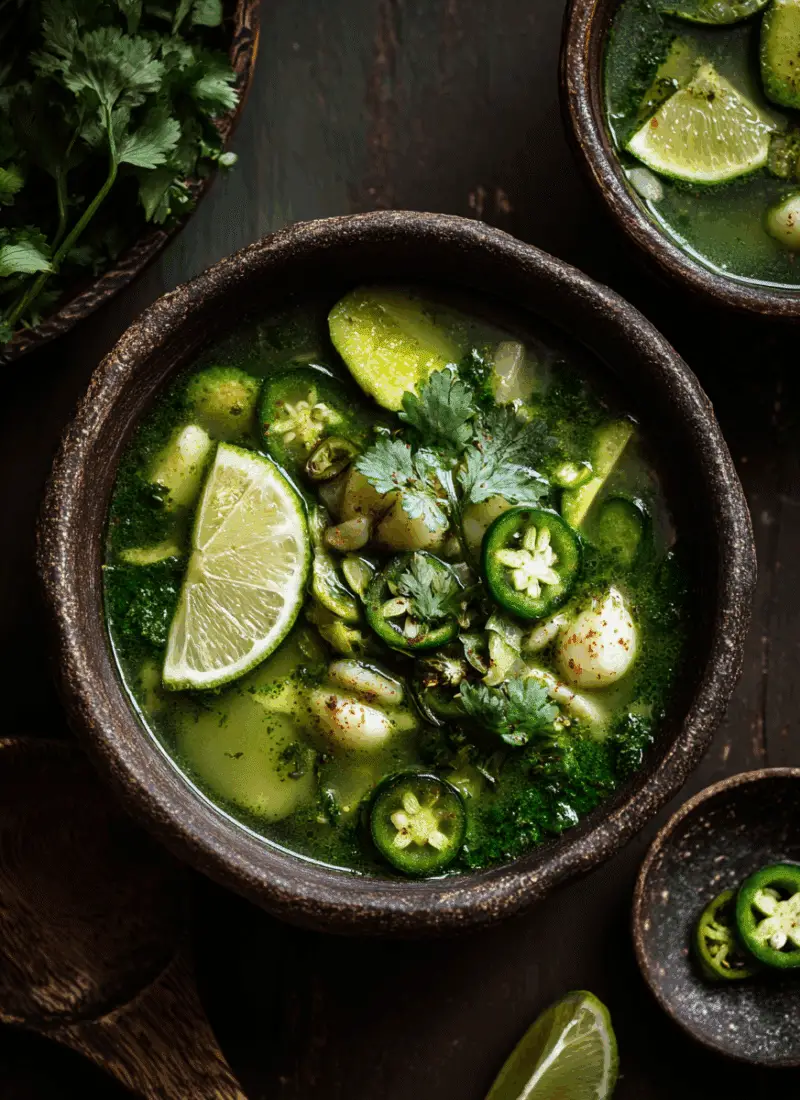Pozole is a traditional Mexican soup that has deep roots in pre-Columbian times and is still widely enjoyed during special occasions, especially Mexican Independence Day. It’s made with hominy (nixtamalized corn kernels) and can be prepared in two main variations: Rojo (red) and Verde (green), each offering unique flavor profiles. Pozole Rojo is rich and smoky due to dried red chiles, while Pozole Verde is vibrant and zesty thanks to green ingredients like tomatillos, poblano peppers, and fresh herbs.
FULL RECIPE
Ingredients
1.For the Base Pozole:
- 2 lbs pork shoulder or chicken thighs (bone-in, skin removed)
- 1 large white onion, halved
- 4 garlic cloves
- 10 cups water (or more as needed)
- 2 tsp salt
- 2 tsp dried oregano
- 2 bay leaves
- 2 (25 oz) cans of hominy, drained and rinsed
2.For Pozole Rojo (Red Sauce):
- 4 dried guajillo chiles, stemmed and seeded
- 2 dried ancho chiles, stemmed and seeded
- 2 garlic cloves
- 1/2 tsp cumin
- 1/4 tsp ground cloves
- 1/2 cup of cooking broth from the meat
3.For Pozole Verde (Green Sauce):
- 1 lb tomatillos, husked and rinsed
- 2 poblano peppers, seeded and chopped
- 1 jalapeño (optional, for heat)
- 1 small white onion, chopped
- 2 garlic cloves
- 1/2 cup fresh cilantro
- 1/2 cup fresh parsley
- 1/2 tsp cumin
- 1 tbsp pumpkin seeds (pepitas), optional
- 1/2 cup of cooking broth from the meat
4.Optional Garnishes:
- Shredded lettuce or cabbage
- Sliced radishes
- Diced onion
- Dried oregano
- Lime wedges
- Tortilla chips or tostadas
- Avocado slices
- Chopped cilantro
Directions
- Cook the Meat: In a large pot, combine pork or chicken, onion halves, garlic cloves, water, salt, oregano, and bay leaves. Bring to a boil, reduce heat, and simmer uncovered for about 1.5 to 2 hours until the meat is tender and easily shreds. Skim off any foam that rises.
- Shred the Meat: Remove the meat from the pot, shred it, and discard bones and any large chunks of fat. Strain the broth if necessary, then return the shredded meat to the pot.
- Prepare the Sauce (Choose Red or Green):
- For Rojo: In a small saucepan, boil the dried chiles for 10 minutes until softened. Blend them with garlic, cumin, cloves, and 1/2 cup broth until smooth. Strain the sauce if desired for a smoother texture.
- For Verde: Boil or roast the tomatillos, poblano peppers, and jalapeño until soft. Blend with onion, garlic, cilantro, parsley, cumin, pumpkin seeds (if using), and 1/2 cup broth until smooth.
- Combine Sauce with Soup Base: Add your chosen sauce (red or green) into the pot with the meat and broth. Stir well to combine and simmer for another 20 minutes to let flavors meld.
- Add Hominy: Stir in the drained hominy and simmer for an additional 15–20 minutes until everything is well heated and the flavors have developed.
- Taste and Adjust: Add salt or more oregano if needed. Adjust the thickness with additional water or broth as preferred.
- Serve: Ladle the hot pozole into bowls. Let everyone customize their bowls with the garnishes of their choice.
Nutrition Facts
- Calories: 350–400 kcal
- Protein: 25–30 g
- Fat: 12–16 g
- Saturated Fat: 3–5 g
- Carbohydrates: 30–35 g
- Fiber: 6–8 g
- Sugars: 3–5 g
- Sodium: 800–950 mg
- Cholesterol: 55–70 mg
- Potassium: 700–850 mg
- Vitamin A: 15–20% DV
- Vitamin C: 25–40% DV
- Iron: 15–20% DV
- Calcium: 6–8% DV
Health Benefits of Pozole
Pozole, particularly when made with lean meats and an abundance of vegetables, can be a nutritious option. Hominy, the primary ingredient, is rich in fiber and essential B vitamins like niacin and folate. It also provides a steady source of carbohydrates for energy. Depending on the broth—verde (green) or rojo (red)—the dish may include tomatillos, chili peppers, garlic, and onions, all of which offer antioxidants and immune-boosting properties. When prepared with skinless chicken or lean pork and without excess fat, pozole becomes a hearty yet balanced meal that supports digestive and cardiovascular health.
Common Proteins Used
Traditionally, pozole is made with pork shoulder, which becomes tender and flavorful after hours of simmering. However, many modern variations have embraced chicken as a lighter, quicker-cooking alternative. For vegetarians, mushrooms or jackfruit can replicate the meaty texture, absorbing the rich broth flavors beautifully. Some coastal regions even prepare pozole with seafood, including shrimp or fish, giving it a coastal twist. The versatility in protein allows the dish to be adapted to dietary preferences while maintaining its hearty and festive character.
Garnish and Topping Traditions
The garnishes are what elevate pozole from soup to celebration. A variety of fresh and crunchy toppings are laid out for diners to personalize their bowl. Common choices include shredded cabbage or lettuce, thinly sliced radishes, diced onions, avocado, oregano, lime wedges, and crushed tostadas or tortilla chips. These additions provide texture, brightness, and acidity that complement the rich, flavorful broth. The variety of garnishes also enhances the visual appeal, making the dish as beautiful as it is delicious and adding an element of interactive fun to the meal.
Serving Suggestions
Pozole is typically served in deep bowls, allowing for plenty of broth, hominy, meat, and toppings in every serving. It’s often enjoyed as a main course due to its hearty nature, especially during lunch or dinner gatherings. To complete the meal, pozole pairs well with a side of warm corn tortillas or freshly fried tostadas. For drinks, traditional options like horchata, tamarindo, or aguas frescas balance the spice and richness of the dish. In festive settings, pozole is often accompanied by music, decorations, and a sense of occasion that underscores its cultural relevance.
Ideal Pairings and Side Dishes
To complement pozole, consider serving traditional Mexican side dishes. Elote (Mexican street corn), refried beans, or a simple guacamole with chips make excellent starters or accompaniments. For dessert, flan or arroz con leche offers a sweet contrast to the savory soup. If serving pozole rojo, a smoky mezcal or dark beer can enhance the deep chili flavors, while pozole verde pairs wonderfully with lighter beverages like a citrusy margarita or sparkling water with lime. These pairings not only round out the meal but also highlight the diverse flavors of Mexican cuisine.
Storage and Reheating Tips
Pozole stores exceptionally well, often tasting even better the next day as the flavors meld. Allow the soup to cool completely before transferring it to airtight containers. It can be refrigerated for up to 5 days or frozen for up to 3 months. When reheating, warm the soup over medium heat on the stove, adding a splash of water or broth if it has thickened too much. Garnishes should always be added fresh, just before serving. Proper storage and reheating practices ensure that pozole remains flavorful and safe to enjoy again and again.
Variations Across Mexico
Each region in Mexico brings its own twist to pozole. In Guerrero, pozole verde is often prepared with pumpkin seeds, giving it a slightly nutty flavor. In Jalisco, pozole rojo is more common, traditionally made with pork and topped with a generous helping of cabbage and radishes. In the north, you might find white pozole, made without chili and appreciated for its simplicity and delicate flavor. These regional nuances celebrate local ingredients and preferences, making pozole not just a single recipe but a canvas for culinary expression across the country.
Conclusion
Pozole verde and rojo are more than just beloved Mexican dishes they are vessels of history, culture, and community. Their vibrant colors and robust flavors make them perfect centerpieces for festive occasions like Mexican Independence Day, but their comfort and versatility ensure they are enjoyed year-round. From its pre-Hispanic origins to modern-day reinterpretations, pozole continues to unite generations around the table.








